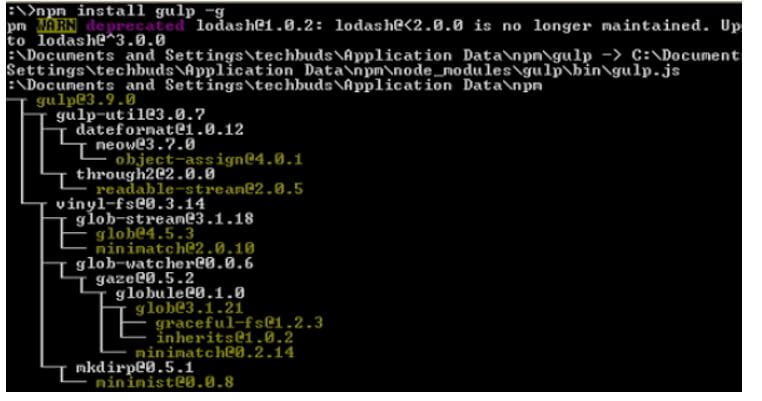Updated February 17, 2023
Introduction to Gulp ESLint
The gulp provides a different kind of feature to the developer; the eslint is one of the features provided by the gulp. A gulp is an open-source tool that automates web tasks per the developer. Eslint is one of the tools used for identifying the patterns from the JavaScript code, the main advantage of this tool is to make code consistent and try to avoid the bugs from the JavaScript; if we want to install eslint, then we need to add the plugins of eslint as per our requirement. Eslint uses expree for parsing JavaScript.
What is Gulp ESLint?
Lint is the most common way to look at your code for possible mistakes. Lint instruments typically permit you to indicate a bunch of rules to look at your code against. These principles can change from general code design, similar to most extreme line length and code space, to how you pronounce capacities.
Linters assist you with composing normalized code to guarantee the quality, limit mistakes, and increment clarity. This is useful while working in groups to ensure all engineers are composing code similarly. In everyday work, assuming designers are working with different documents with a steady format, it makes the code simpler to peruse, which implies engineers can work quicker, saving time. Linters likewise offer execution benefits in featuring wasteful or unused code. We usually need the best client experience for our clients, and keeping the code as effective and lightweight as conceivable to lessen page load time is a significant piece of that.
The most well-known JavaScript linting apparatuses are ESLint, JSHint, JSLint, and JSCS — we will utilize ESLint. It’s entirely adaptable, simple to utilize, and has the best ES6 support, which will be helpful if we present more current JavaScript.
We could introduce ESLint worldwide and run it from the order line utilizing the order eslint. Notwithstanding, in this instructional exercise, we will involve ESLint in a gulp venture, implying we can introduce ESLint, and every vital reliance, locally. This is helpful for others on the undertaking as all conditions are kept ideally inside the task (recorded in the package.json) and will not need any additional work or worldwide establishments.
How to Fix Files Gulp ESLint?
Let’s see how we can fix files in eslint as follows:
There are multiple options to fix the files with the help of gulp eslint.
Code:
const {
src, task
} = require('gulp');
const eslintf = require('gulp-eslint');
task('eslintsample', () => {
return src(['Gulp/Demo/scripts/*.js'])
// eslint() used to attaches output of lint
// file object is used to another module
.pipe(eslint())
// output of eslint will be printed on console
.pipe(eslintf.format())
.pipe(eslintf.failAfterError());
});
gulp.src(['Gulp/Demo/.js', 'node'])
.pipe(eslint({
rules: {
'rule': 2,
'strict':3
},
globals: [
'jQuery',
'$'
],
envs: [
'browser'
]
}))
.pipe(eslintf.formatEach('compact', process.stderr));For fixing files in eslint, we have multiple option lines above.
Configuration Gulp ESLint
Let’s see how we can configure the gulp eslint as follows:
But first, we need to confirm all setup and installation of gulp with the help of the following command.
Code:
node -vExplanation:
- Using the above command, we can see the installed version of Node.js; after execution, we can see the result in the following command.
Output:
In the command line prompt, enter the accompanying order to show the variant of npm (Node.js bundle chief), which is utilized to introduce modules. It will show the introduced Node.js form with the help of the below command.
Code:
npm -vExplanation:
- After executing the above command, we can see the currently installed version of npm on our machine, as shown in the screenshot below.
Output:
We successfully installed Node.js; now, we need to install the gulp by using the below command.
Code:
npm install gulp -gExplanation:
- In the above command, we use g for a flag that ensures gulp is globally available for all projects. After entering the above command, we get the following screen, as shown in the below screenshot.
Output:
To verify gulp, we need to run the below command as follows.
Code:
gulp –vExplanation:
- After executing the above command, we get the currently installed version of a gulp, as shown in the screenshot below.
Output:
Now install the eslint with the help of the below command as follows.
Code:
npm install eslint --save-devWe need to understand the migration if we try to use an older version.
Assuming you are migrating from gulp eslint, you most likely won’t have to change any settings in your gulp task. Gulp eslint-new can deal with the more significant part of the choices utilized with gulp eslint, albeit some are presently deplored for another name or organization.
ESLint might be designed explicitly using the accompanying module choices: config, rules, globals, or env. If the useEslintrc choice isn’t set to bogus, ESLint will endeavor to determine a record by the name of .eslintrc inside a similar registry as the document to be lint. If not found there, parent registries will be looked at until .eslintrc is found or the index root is reached as follows.
Code:
{
"Eslint_rules": {
"specified name of rule": ["errorvalue", "alwaysvalue"],
"specified name of rule": ["errorvalue", "doublevalue"]
}
}Explanation:
- In the above rule, we can define the specified name of the rule that we want and set the value of the rules, as shown in the above example.
- As per our covalence, we can set the code 0 for rule off, 1 for rule on, and 2 for rule on but exit error.
Now let’s see an example as follows:
Code:
var gulpf = require('gulp');
var eslintf = require('gulp-eslint');
var gulpIff = require('gulp-if');
gulp.task('eslintfile', () => { return gulp.src('Gulp/Demo/sample/exp.js')
.pipe(eslint())
.pipe(eslint.format())
.pipe(eslint.failAfterError()) });
isFixed(file) { return file.eslint !== null && file.eslint.fixed; }
gulp.task('eslint-fix', () => { return gulp.src(' Gulp/Demo/sample/exp.js ')
.pipe(eslint({ fix: true, }))
.pipe(eslint.format())
.pipe(gulpIf(isFixed, gulp.dest(' Gulp/Demo/sample/')))
.pipe(eslint.failAfterError()) });Explanation:
- End result of the above implementation can see in the below screenshot.
Output:
Conclusion
With the help of the above article, we saw about the Gulp eslint. From this article, we learned basic things about the Gulp eslint and saw the integration of the Gulp eslint and how we use it in the Gulp eslint.
Recommended Articles
This is a guide to Gulp ESLint. Here we discuss the introduction, how to fix files gulp ESLint with Configuration. You may also have a look at the following articles to learn more –






